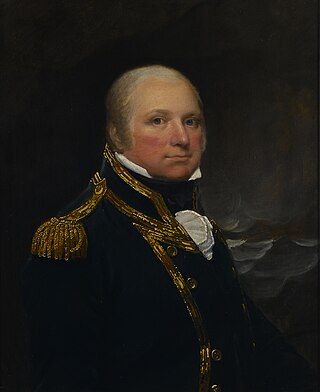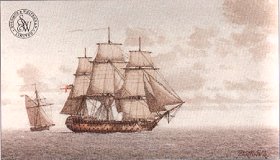Michael Duffy is a naval historian, [1] specialising in the Napoleonic war period. He is reader in British history and director of the Centre for Maritime Historical Studies at the University of Exeter.
Michael Duffy is a naval historian, [1] specialising in the Napoleonic war period. He is reader in British history and director of the Centre for Maritime Historical Studies at the University of Exeter.
Duffy earned his BA in history, MA, and DPhil in history at the University of Oxford. Appointed to the faculty of the University of Exeter, he has been assistant lecturer, lecturer, senior lecturer, head of history and dean of arts. Appointed director of the Centre for Maritime Historical Studies in 1991, he was promoted to reader in British history in 2001.
He has been vice-president of the Navy Records Society and editor of the Mariner's Mirror.

HMS Bellerophon, known to sailors as the "Billy Ruffian", was a ship of the line of the Royal Navy. A third-rate of 74 guns, she was launched in 1786. Bellerophon served during the French Revolutionary and Napoleonic Wars, mostly on blockades or convoy escort duties. She fought in three fleet actions: the Glorious First of June (1794), the Battle of the Nile (1798) and the Battle of Trafalgar (1805). While the ship was on blockade duty in 1815, Napoleon boarded Bellerophon so he could surrender to the ship's captain, ending 22 years of almost continuous war between Britain and France.

John Brewster Hattendorf, D.Phil., D.Litt., L.H.D., FRHistS, FSNR, is an American naval historian. He is the author, co-author, editor, or co-editor of more than fifty books, mainly on British and American maritime history and naval warfare. In 2005, the U.S. Naval Institute Proceedings described him as "one of the most widely known and well-respected naval historians in the world." In reference to his work on the history of naval strategy, an academic in Britain termed him the "doyen of US naval educators." A Dutch scholar went further to say that Hattendorf "may rightly be called one of the most influential maritime historians in the world." From 1984 to 2016, he was the Ernest J. King Professor of Maritime History at the United States Naval War College in Newport, Rhode Island. He has called maritime history "a subject that touches on both the greatest moments of the human spirit as well as on the worst, including war." In 2011, the Naval War College announced the establishment of the Hattendorf Prize for Distinguished Original Research in Maritime History, named for him. The 2014 Oxford Naval Conference - "Strategy and the Sea" - celebrated his distinguished career on April 10–12, 2014. The proceedings of the conference were published as a festschrift. In March 2016, Hattendorf received the higher doctorate of Doctor of Letters (D.Litt.) from the University of Oxford. Among the few Americans to have received such designation, Hattendorf remained actively engaged on the Naval War College campus after his formal retirement in 2016.

HMS Defence was a 74-gun Bellona-class third-rate ship of the line of the Royal Navy, built by Israel Pownoll and launched on 31 March 1763 at Plymouth Dockyard. She was one of the most famous ships of the period, taking part in several of the most important naval battles of the French Revolutionary and Napoleonic wars. In 1811 she was wrecked off the coast of Jutland with the loss of almost her entire crew.

Andrew Lambert is a British naval historian, who since 2001 has been the Laughton Professor of Naval History in the Department of War Studies, King's College London.

John Cooke was an experienced and highly regarded officer of the Royal Navy during the American War of Independence, the French Revolutionary Wars and the first years of the Napoleonic Wars. Cooke is best known for his death in hand-to-hand combat with French forces during the Battle of Trafalgar in 1805. During the action, his ship HMS Bellerophon was badly damaged and boarded by sailors and marines from the French ship of the line Aigle. Cooke was killed in the ensuing melee, but his crew successfully drove off their opponents and ultimately forced the surrender of Aigle.

Geoffrey Till is a British naval historian and emeritus Professor of Maritime Studies in the Defence Studies Department of King's College London. He is the Director of the Corbett Centre for Maritime Policy Studies.

Tor Bay is a bay on the south-east coast of the county of Devon, England. Facing east into the English Channel, it is about 4.5 mi (7.2 km) wide from north to south. The settlements of Torquay, Paignton and Brixham, which lie along its coastline, are known collectively as Torbay.

The Navy Records Society was established in 1893 as a scholarly text publication society to publish historical documents relating to the history of the Royal Navy. Professor Sir John Knox Laughton and Admiral Sir Cyprian Bridge were the key leaders who organized the society, basing it on the model of earlier organisations such as the Hakluyt Society and the Camden Society. The American naval historian, Rear Admiral Alfred Thayer Mahan, was one of the first overseas members to join the Navy Records Society.
Alan William Halliday Pearsall ISO, was a naval and railway historian, who served for thirty years from 1955 to 1985 on the staff of the National Maritime Museum, Greenwich.

HMS Edgar was a 74-gun third-rate ship of the line of the Royal Navy, that saw service in the American Revolutionary, French Revolutionary and Napoleonic Wars. Launched in 1779, she fought in the battles of Cape St Vincent and Copenhagen, two of the major naval engagements of the wars.

Admiral Sir Roger Curtis, 1st Baronet, GCB was an officer of the British Royal Navy, who saw action in several battles during an extensive career that was punctuated by a number of highly controversial incidents. Curtis served during the American Revolutionary War and the French Revolutionary Wars and was highly praised in the former conflict for his bravery under fire at the Great Siege of Gibraltar, where he saved several hundred Spanish lives at great risk to his own. His career suffered however in the aftermath of the Glorious First of June, when he was heavily criticised for his conduct by several influential figures, including Cuthbert Collingwood. His popularity fell further due to his involvement in two highly controversial courts-martial, those of Anthony Molloy in 1795 and James Gambier in 1810.

Captain George Miller Bligh (1780–1834) was an officer of the Royal Navy, who saw service during the French Revolutionary and Napoleonic Wars, eventually rising to the rank of Captain. He was present aboard HMS Victory at the Battle of Trafalgar, and was badly wounded during the action. He was taken below and was present in the cockpit at the death of Vice-Admiral Horatio Nelson.
Sir James Lind KCB was an officer of the Royal Navy who served during the American War of Independence and the French Revolutionary and Napoleonic Wars. The son of James Lind, a distinguished naval physician, Lind also embarked on a career at sea, but served in a more front line role. After serving on a number of different ships he finally received his own command in 1800, but his first chance to show his ability came only in 1803 when in command of HMS Sheerness. Here he captured a French privateer after his imitation of a merchant ship encouraged the privateer to actually attack his heavily armed frigate. He then revealed the true nature of his ship and the hapless privateer had no choice but to swiftly surrender. Promoted to command the 50-gun HMS Centurion Lind had another opportunity to distinguish himself, when the convoy under his protection was attacked in the harbour of Vizagapatnam by a heavily armed French squadron under Rear-Admiral Charles-Alexandre Durand Linois. Despite being on shore at the time Lind hurried back to take command and supervise operations to resist the French, who though were able to capture one of the merchants, decided not to risk pressing the attack on the Centurion and withdrew. The survival of the Centurion in the face of overwhelming forces was hailed as a great achievement back home in Britain, with Lind being knighted for his efforts.

Admiral of the Fleet Sir George Martin was an officer of the Royal Navy who saw service during the American War of Independence, and the French Revolutionary and Napoleonic Wars. During his long naval career he took part in several significant battles, for which he was awarded a number of honours and promotions; he commanded ships at Cape St Vincent and Cape Finisterre.
HMS Aeolus was a 32-gun Amphion-class fifth-rate frigate of the Royal Navy. She was launched in 1801 and served in the French Revolutionary and Napoleonic Wars, and the War of 1812.
Brian Lavery, is a British naval historian, author, and Curator Emeritus at the National Maritime Museum, Greenwich, London, England.
Charles Iain Hamilton is a naval historian at the University of the Witwatersrand, Johannesburg, South Africa.
Peter G Hore FRHistS naval officer, historian and obituarist, served a full career in the Royal Navy (1962-2000), spent ten years working in the cinema and television industry (2000-2009) and is a successful biographer and obituarist. One of his books, Habit of Victory, was the Daily Telegraph reader's choice and another book, Sydney, Cipher and Search was praised for its literary quality and depth of research and shortlisted for the Mountbatten Media Awards. His reasons for becoming an historian are published at British Naval History.

The Western Squadron was a squadron or formation of the Royal Navy based at Plymouth Dockyard. It operated in waters of the English Channel, the Western Approaches, and the North Atlantic. It defended British trade sea lanes from 1650 to 1814 and 1831 to 1854. Following Admiralty orders to Lord Anson he was instructed to combine all existing commands in the English Channel - those at the Downs, Narrow Seas, Plymouth and the Spithead - under a centralized command under the Commander-in-Chief, Western Squadron in 1746. The squadron was commanded by the Flag Officer with the dual title of Commander-in-Chief, English Channel and Commander-in-Chief, Western Squadron

HMS Resistance was a 36-gun fifth-rate Aigle-class frigate of the Royal Navy, one of a pair designed by Sir John Henslow. Resistance was commissioned in May 1801 by Captain Henry Digby, and after brief service in the English Channel the frigate left for Quebec in charge of a convoy. While on voyage Resistance captured the French privateer Elizabeth, which was the last ship captured during the French Revolutionary War. Having returned to England at the end of the year, the frigate resumed service in the English Channel, with Captain Philip Wodehouse replacing Digby. On 31 May 1803 Resistance was sailing to the Mediterranean Sea when she was wrecked off Cape St. Vincent; the crew survived.